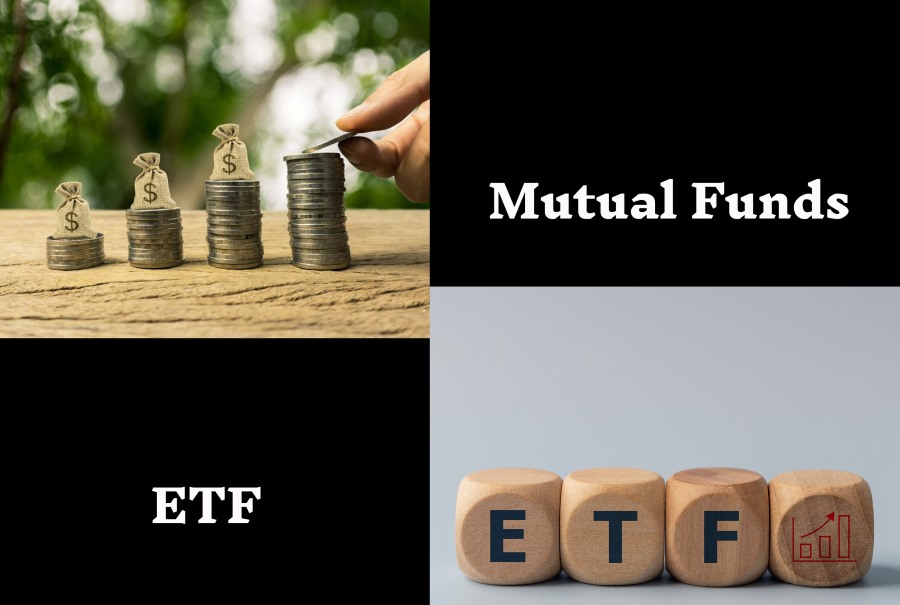Simplifying Life Insurance in India
Difference Between Exchange Traded Funds and Mutual Funds Explained

ETFs and mutual funds are popular investment products. However, their structure and trading mechanisms differ vastly.
Such trades happen on the stock exchange, like individual stocks. At the end of the trading day, investors buy and sell mutual funds based on their NAV.
Understanding the difference between ETFs and mutual funds is essential in investing. Both provide advantages that suit the investor's goal, risk tolerance, and preferences.
Keep reading to learn more about how an ETF differs from mutual funds, its risk, and other important factors.

Table of Contents

What are Exchange Traded Funds?
Exchange-traded funds, or ETFs, are mostly passively managed funds traded on the stock exchange. They comprise stocks and bonds that carry the underlying index's exact value. Individuals can buy, sell, and transfer them quickly.
ETFs are traded throughout the day, so the value of the assets fluctuates, so you need to buy them at their current market price. As mentioned, ETFs solely replicate an index, thus requiring no fund manager to monitor them actively.
ETFs are used for purposes like arbitrage, hedging, and equitising cash. The shareholders receive dividends paid and interest earned as a part of the profit.
What are Mutual Funds?
Mutual funds accumulate funds from various investors and trade in diversified assets. Professional fund managers actively manage these investment funds. These investors put their money in bonds, stocks, debt, or money market instruments.
You purchase or sell a mutual fund at its Net Asset Value or NAV. You can obtain it by dividing the total assets by the number of investors.
The investors hold a share of a mutual fund and experience the same profit or loss as other investors.
Exchange Traded Funds vs Mutual Funds: Which is Better?
Here's a tabular representation of the difference between ETF and mutual funds in India.
If you ever wonder which is better among ETF vs mutual funds, you may consider the following factors -
- Your risk appetite
- Liquidity of your investments
- Your investment horizon
- Your financial goals
- Expense ratio
Types of ETFs
There are various types of exchange-traded funds (ETFs), such as:
Types of Mutual Funds
Mutual funds can be categorized in several ways, including by asset class, risk, and investment strategy:
Benefits of ETFs and Mutual Funds
ETF is an attractive investment option for most investors. However, mutual Funds also offer many advantages that explain their popularity in investors' minds. Here are some significant benefits of investing in both:
Once you have your priorities set, you can choose your investment. Mutual funds generally require a longer investment horizon than exchange-traded funds. On the other hand, ETFs offer you higher returns, more flexibility, and tax benefits in the short run.
Now that you know about exchange-traded funds (ETF) versus mutual funds, you can utilize both to build a diversified portfolio.
Disclaimer: The information provided on this website is for general informational purposes only and should not be construed as financial, investment, or legal advice. While we strive to provide accurate and up-to-date content, we do not guarantee the completeness, reliability, or suitability of the information for your specific needs.
We do not promote or endorse any financial product or service mentioned in these articles. Readers are advised to conduct their own research, consult with financial experts, and make informed decisions based on their unique financial circumstances. Any reliance you place on the information provided here is strictly at your own risk.
FAQs about ETF vs Mutual Funds
Which is better, mutual funds or an ETF?
Do ETFs grow faster than mutual funds?
Why is a mutual fund expensive when compared to an ETF?
Are ETFs riskier than Mutual funds?
What is the difference between ETFs and mutual funds?
What are the advantages of mutual funds over ETFs?
Does ETF have an exit load?
Are ETFs tax-efficient when compared to mutual funds?
Why should I choose an ETF over mutual funds?
Which one among ETFs and mutual funds has a lock-in period?
Other Important Articles about Mutual Funds
Disclaimer
- This is an informative article provided on 'as is' basis for awareness purpose only and not intended as a professional advice. The content of the article is derived from various open sources across the Internet. Digit Life Insurance is not promoting or recommending any aspect in the article or its correctness. Please verify the information and your requirement before taking any decisions.
- All the figures reflected in the article are for illustrative purposes. The premium for Coverage that one buys depends on various factors including customer requirements, eligibility, age, demography, insurance provider, product, coverage amount, term and other factors
- Tax Benefits, if applicable depend on the Tax Regime opted by the individual and the applicable tax provision. Please consult your Tax consultant before making any decision.
Latest News
27-03-2025
Life Insurance: Is 10x Income Enough Coverage In 2025?
A survey by Bajaj Allianz Life Insurance and NielsenIQ reveals that 1 in 3 Indians have never reviewed their life insurance coverage, even after major life events. While 81% believe coverage less than 10 times their annual income is adequate, the actual average is just 3.1 times. This highlights a significant financial protection gap. Despite this, 82% of Indians are confident in their current policies. The survey underscores the need for better financial awareness and adequate life insurance coverage in India.
27-03-2025
Huge Insurance Deals! ₹38,000 Cr Changed Hands Quickly.
In the past two weeks, the insurance industry saw major deals worth over Rs 38,000 crore. The largest was Bajaj Group's Rs 24,180 crore acquisition of Allianz’s stake in their joint ventures. Patanjali acquired a stake in Magma General Insurance, and IndusInd International Holdings bought Reliance Capital, which owns Reliance Nippon Life and Reliance General Insurance. Additionally, the UK-based Prudential Group partnered with HCL Group to create a standalone health insurance company.
26-03-2025
Green Portfolio Unveils New AIF with a Target Corpus of ₹300 Crore
Green Portfolio has officially launched its Alternative Investment Fund (AIF) as of March 26, with an ambitious target of Rs 300 crore and they’ve already secured over 50% of investor commitments! This Category III fund is set to seize opportunities in pre-IPO, private markets, and listed equities, dedicating 70-80% of its investments to small, mid, and micro-cap stocks, while allocating 20-30% to pre-IPO and private assets. Co-founder Divam Sharma highlights this venture as a game-changer, providing clients with unique investment avenues in addition to their Portfolio Management Services (PMS).
25-03-2025
₹62 Lakh Crore: Life Insurance Industry's Growth Explained
IRDAI data shows the life insurance industry's AUM grew over 9%, from Rs. 55 lakh crore in March 2023 to Rs. 62 lakh crore in March 2024. LIC India leads with Rs. 44 lakh crore, 72% of the total AUM. Private players hold Rs. 18 lakh crore. SBI Life and HDFC Life follow with Rs. 3.85 lakh crore and Rs. 2.87 lakh crore, respectively. Tata AIA Life saw the highest growth at 39%. New entrants include Go Digit Life, Credit Access Life, and Acko Life.
25-03-2025
₹62 Lakh Crore: Life Insurance Industry's Growth Explained
IRDAI data shows the life insurance industry's AUM grew over 9%, from Rs. 55 lakh crore in March 2023 to Rs. 62 lakh crore in March 2024. LIC India leads with Rs. 44 lakh crore, 72% of the total AUM. Private players hold Rs. 18 lakh crore. SBI Life and HDFC Life follow with Rs. 3.85 lakh crore and Rs. 2.87 lakh crore, respectively. Tata AIA Life saw the highest growth at 39%. New entrants include Go Digit Life, Credit Access Life, and Acko Life.
18-03-2025
Gold Price Nears Record High: Time to Reconsider Your Portfolio
Gold is a good hedge, so allocating 5-15% to it is wise. In 2024, gold gave over 20% returns, while Nifty gave 8.7%. Gold prices in India are nearing ₹90,000 per gram due to safe-haven buying amid US recession fears. Recently, gold surged 3% due to US tariffs and trade tensions. Experts advise caution at high levels, as gold is volatile. Central banks' policies and economic conditions will impact gold's future prices.
18-03-2025
Gold Price Nears Record High: Time to Reconsider Your Portfolio
Gold is a good hedge, so allocating 5-15% to it is wise. In 2024, gold gave over 20% returns, while Nifty gave 8.7%. Gold prices in India are nearing ₹90,000 per gram due to safe-haven buying amid US recession fears. Recently, gold surged 3% due to US tariffs and trade tensions. Experts advise caution at high levels, as gold is volatile. Central banks' policies and economic conditions will impact gold's future prices.
17-03-2025
Fixed Income 101: Everything You Should Know in 2025
Bond prices are expected to rise over the next 9-12 months, offering capital gains opportunities. In 2024, bonds performed well, with the Crisil Composite Bond index up 9%. The RBI's unchanged repo rate, slowing growth, and favorable bond demand-supply balance supported this performance. Looking ahead, a positive macroeconomic environment, easing financial conditions, and strong bond demand are expected to further boost bond prices, making them a stable and attractive investment option.
17-03-2025
Fixed Income 101: Everything You Should Know in 2025
Bond prices are expected to rise over the next 9-12 months, offering capital gains opportunities. In 2024, bonds performed well, with the Crisil Composite Bond index up 9%. The RBI's unchanged repo rate, slowing growth, and favorable bond demand-supply balance supported this performance. Looking ahead, a positive macroeconomic environment, easing financial conditions, and strong bond demand are expected to further boost bond prices, making them a stable and attractive investment option.
14-03-2025
Succeeding in a Downturn: Focused Funds Attract Investor Attention.
In the last three months, largecap mutual funds saw an 11% increase in net inflows, while focused funds rose by 67%. Market volatility led to a drop in midcap and smallcap fund inflows. As deposit and credit growth improve, concerns about asset quality should ease, benefiting financial stocks. In February, focused funds were the only equity segment with increased net flows, rising 64.45% to ₹1,287.72 crore, despite a 26.17% drop in overall equity fund inflows.
Read More
















